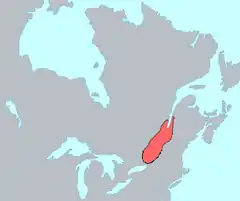Laurentian language
Laurentian, or St. Lawrence Iroquoian, was an Iroquoian language spoken until the late 16th century along the shores of the Saint Lawrence River in present-day Quebec and Ontario, Canada. It is believed to have disappeared with the extinction of the St. Lawrence Iroquoians, likely as a result of warfare by the more powerful Mohawk from the Haudenosaunee or Iroquois Confederacy to the south, in present-day New York state of the United States.
| Laurentian | |
|---|---|
| Native to | Canada |
| Region | Saint Lawrence River Valley |
| Extinct | late 16th century |
Iroquoian
| |
| Language codes | |
| ISO 639-3 | lre |
lre | |
| Glottolog | laur1250 |
 Territory occupied by the St. Lawrence Iroquois, circa 1535 | |
| Indigenous peoples in Canada |
|---|
.JPG.webp) |
|
History
The explorer Jacques Cartier observed in 1535 and 1536 about a dozen villages in the valley between Stadacona and Hochelega, the sites of the modern cities of Quebec City and Montreal.[1] Archeologists have unearthed other villages farther west, near the eastern end of Lake Ontario. St. Lawrence Iroquoians lived in villages which were usually located a few kilometres inland from the Saint-Lawrence River, and were often enclosed by a wooden palisade. Up to 2000 persons lived in the larger villages.
By the time the explorer Samuel de Champlain arrived in 1608, however, he found no trace of the Iroquoians visited by Jacques Cartier some 75 years earlier.[2] Scholars have developed several theories to explain the complete disappearance of the St. Lawrence Iroquoians, among them devastating wars waged by the Mohawk from the south, epidemics of Old World infectious diseases, or migration towards the Great Lakes region. Archeological evidence points most strongly to devastating wars with neighbouring Iroquoian tribes, the Huron and the nations of the Iroquois League, especially the Mohawk.[3]
Classification
Several dialects of Laurentian may have existed in the 16th century in the St. Lawrence River valley. The sparse records made by Jacques Cartier during his voyages cannot be considered conclusive, and the Laurentians may have spoken several distinct languages.[4] A few Laurentian words are still in use today as toponyms: most notably the word canada, meaning "village" in Laurentian. Jacques Cartier used the word to describe both the region and the river that crosses it. The name of Donnacona, the Iroquoian chieftain Cartier met at Stadacona, remains in use as the name of the town of Donnacona, Quebec. Hochelaga remains in use in the Montreal borough of Hochelaga-Maisonneuve and the alternate spelling "Osheaga" serves as the name of Montreal's annual Osheaga Festival.
On the basis of the Laurentian vocabularies of Cartier, the linguist Marianne Mithun concludes that Laurentian was an Iroquoian language, and its speakers were "clearly in contact with the Lake Iroquoian peoples [Huron and Iroquois]" (Mithun, 1981).
Laurentian vocabularies
In 1545 Jacques Cartier published a journal of his voyages, including the first list of Laurentian words. Here are some examples (numbers and parts of the human body), as written by Cartier:
| English (from French) |
Laurentian |
|---|---|
| one | segada |
| two | tigneny |
| three | asche |
| four | honnacon |
| five | ouiscon |
| head | aggourzy |
| eyes | hegata |
| ears | ahontascon |
| mouth | escahe |
| teeth | esgougay |
| tongue | osvache |
| village | canada |
A second shorter vocabulary list was appended to his journal of his first voyage, which was published much later, first in Italian and later in English and French.
References
- Jacques Cartier. (1545). Relation originale de Jacques Cartier. Paris: Tross (1863 edition)
- James F. Pendergast. (1998). "The Confusing Identities Attributed to Stadacona and Hochelaga" Archived 2014-08-12 at the Wayback Machine, Journal of Canadian Studies, Volume 32, p. 149, accessed 3 Feb 2010
- Bruce G. Trigger, "The Disappearance of the St. Lawrence Iroquoians", in The Children of Aataenstic: A History of the Huron People to 1660, vol. 2], Montreal and London: Mcgill-Queen's University Press, 1976, pp. 214-218, 220-224, accessed 2 Feb 2010
- James F. Pendergast. (1998). "The Confusing Identities Attributed to Stadacona and Hochelaga" Archived 2014-08-12 at the Wayback Machine, Journal of Canadian Studies, Volume 32, pp. 156-157, accessed 3 Feb 2010
- Jacques Cartier. (1545). Relation originale de Jacques Cartier. Paris: Tross (1863 edition). (Vocabulary list on pages 46 to 48)
- Floyd G. Lounsbury. (1978). "Iroquoian Languages," Handbook of North American Indians. Volume 15. Pages 334-343.
- Juan Francisco Maura. (2009). "Nuevas aportaciones al estudio de la toponimia ibérica en la América Septentrional en el siglo XVI". Bulletin of Spanish Studies 86. 5 (2009): 577-603.
- Marianne Mithun. (1979). "Iroquoian," in Lyle Campbell and Marianne Mithun, The Languages of Native America. Austin: University of Texas Press. Pages 140-141. ("Laurentian")
- Marianne Mithun. (1981). The Mystery of the Vanished Laurentians, in Papers from the 5th International Congress on Historical Linguistics (Anders Ahlquist, ed.). Amsterdam: John Benjamins. Pages 230-242.
- Marianne Mithun. (1999). The languages of Native North America. Cambridge: Cambridge University Press. ISBN 0-521-23228-7 (hbk); ISBN 0-521-29875-X.
- James F. Pendergast. (1998). "The Confusing Identities Attributed to Stadacona and Hochelaga", Journal of Canadian Studies. Volume 32. Pages 149-167.
- Bruce G. Trigger and James F. Pendergast. (1978). "Saint Lawrence Iroquoians", Handbook of North American Indians. Volume 15. Pages 357-361.
- Bruce G. Trigger. (1976). The Children of Aataentsic: a History of the Huron People to 1660. Montreal: McGill-Queen's Press. pp. 214–228. ("The Disappearance of the St. Lawrence Iroquoians")
External links
- List of Web sites on the Laurentian language (Native Languages of the Americas Online Resources)
- Laurentian words
